Defects or Imperfections in Solids:
An ideal ionic crystal is that in which ions have a definite repeating arrangement. When some ions do not occupy theoretical positions, ionic structure shows some deviations called defects. Properties of ionic crystals such as electrical-conductivity, colour and mechanical properties are modified due to these defects. These imperfections may be at a point, over a surface or along a line. The number of defects (n) per cm3 are given by the relation:
n = Ne-W/2RT
Where,
N = Avogadro’s number
e = The base of natural logarithm
W = The work or energy required to produce a defect
R = Gas constant
T = Temperature on Kelvin.
There are commonly two types of imperfections viz,
(i) Electronic imperfections.
(ii) Atomic imperfections or point defects.
Electronic Imperfections: –
These are the defects in the ionic crystals due to electrons. In the perfectly ionic (e.g., NaCl) or covalent crystals (e.g., Si) at 0K, the electrons occupy fully the lowest energy states. The arrangement of the valence electrons depends on the nature of the chemical bond. However at temperatures above 0K, some of the electrons may occupy higher energy states, depending upon the temperature. For example, in the crystals of pure silicon, some of the electrons from the covalent bonds get thermally released. These electrons are mobile and are responsible for the electrical conductivity of silicon. The bonds from which electrons have been removed become electron deficient and are called holes. Holes also impart electrical conductivity. However, holes in an electronic field move in a direction opposite to that in which electrons move. Free electrons and holes in solids are considered to be electronic imperfections and are responsible for electrical conductivity.
Point Defects or Atomic imperfections:-
The point defects in crystals arise due to the absence of some ions from the lattice sites or occupancy of vacant lattice sites or interstitial sites. The defects in crystals are mainly of two types as described below for the ionic compounds of the type A+B–.
Point Defects in Stoichiometric crystals:
Stoichiometric compounds are those compounds in which the number of positive and negative ions is in the same ratio as indicated by their chemical formulae.
At absolute zero, the ions are arranged in a regular fashion in the crystal. However, on increasing the temperature, the chance for an ion to escape from the lattice site and thus to create a vacant site increases. This constitutes a defect. Since the number of defects depends upon the temperature, the defects produced are sometimes called thermodynamic defects. These are of two types:
Schottky defects:
These defects arise in a crystal when cation and anion are missing in equal number from their normal lattice site and as a result, a pair of holes is formed. Because of these holes, there is an increase in the volume of the crystal with no increase in its mass. As a result, the density as well as covalent character of the crystalline solid decreases. Since the number of missing positive ions is equal to the missing negative ions, the crystal as a whole is electrically neutral.
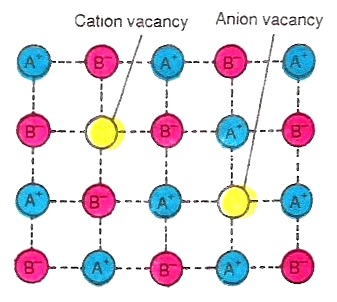
Fig: Schottky defect in crystals
Conditions causing Schottky defects: This type of defect is generally observed in case of strongly ionic compounds with high co-ordination number and having positive and negative ions of same size. Examples of compounds having this type of defect are: NaC1, KC1, KBr and CsC1.
Frenkel defects:
Frenkel defect arises when an ion is missing from its normal position and occupies an interstitial site between the lattice points. The existence of one hole due to a missing cation from its normal position and occupying an interstitial position. The reason for occupying interstitial position by a cation and not anion is that the size of positive ion is smaller than that of an anion. The crystal remains electrically neutral because the number of cations and anions remains the same. For example, in the crystal lattice of ZnS, AgCl, AgBr and AgI, the Zn+2 and Ag+ ions occupy interstitial sites and leave behind a hole (or vacant place). Frenkel defects increase with rise in temperature. The production of this defect does not change the density of the crystals.
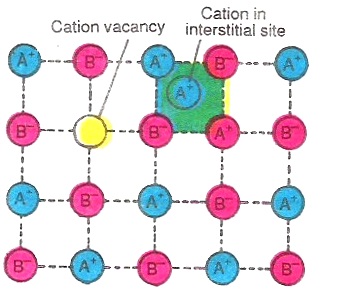
Fig: Frenkel defect in crystals
Conditions causing Frenkal defects. This defect generally occurs in compounds having low co-ordination number and in which anions are much larger than cations. Due to this defect, the covalent character of the crystalline solid decreases.
Consequences of Schottky and Frenkel Defects:
The ionic compounds having Schottky and Frenkel defects show following properties—
(1) Crystals have low density due to the presence of ‘holes’ in them.
(2) These compounds have lower lattice energy and thus low stability.
(3) The closeness of similar charges brought about by Frenkel defect tends to increase the dielectric constant of the crystals.
(4) Compounds having Schottky and Frenkel defect conduct electricity to a small extent by an ionic mechanism.
Point Defects in Non-stoichiometric crystals:
Non-stoichiometric compounds are those in which the number of positive and negative ions are not in the same ratio as indicated by their chemical formulae. [e.g. Fe0.95O, Cu1.97S and VOx, where x ranges from 0.6 to 1.3].
These compounds either contain excess positive or negative ions. However, the crystal as a whole is electrically neutral. If positive charges are in excess, these are balanced by the presence of extra negative charges. As a result, crystal structure becomes irregular and defective. Such defects are called non -stiochiometric defects. These defects are two types and may exist in a crystal in addition to the Schottky and Frenkel defects.
Metal Excess Defects:
In these defects, the positive ions are in excess. These may arise due to the following two ways:
1) Anion vacancies:
In this case, negative ions may be missing from their lattice sites leaving holes in which the electrons remain entrapped to maintain the electrical neutrality. Evidently, there is an excess of positive (metal) ions although the crystal as a whole is electrically neutral. This type of defect is observed in those crystals which are likely to form Schottky defects. e.g. in alkali metal halides, anion vacancies are produced when alkali metal halide crystals are heated in the atmosphere of the alkali metal vappurs. The metal atoms get deposited on the surface of the alkali metal halide crystal, halide ions move onto the surface and combine with metal atoms. The electrons, thus produced by the ionization of the metal atoms diffuse into the crystal and get trapped at the anion vacancies. The electrons trapped in anion vacancies are referred to as F-centres.
These give very interesting properties. E.g. the excess of potassium in KCl makes the crystal appear violet; excess of lithium in LiCl makes the crystal appear pink.
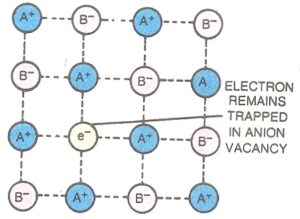
Fig: Metal excess defects due to anion vacancy
2) Extra cations occupying the interstitial sites.
In this case, there are extra positive ions occupying interstitial sites and the electrons in another interstitial site to maintain electrical neutrality. The defects may be visualised as the loss of non-metal atoms which leave their electrons behind. The excess metal ions occupy interstitial positions.
This type of defect is found in crystals which are likely to develop Frenkel defect. The common example is zinc oxide. Zinc oxide (ZnO) loses oxygen reversibly at high temperatures and turns yellow in colour. The excess Zn2+ ions are trapped in interstitial sites and equal numbers of electrons are trapped in the neighbourhood to balance the electrical charge. These electrons give rise to enhanced electrical conductivity.
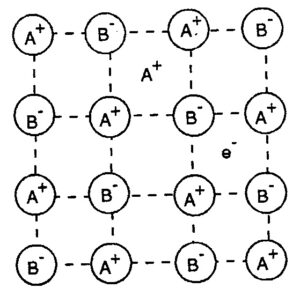
Fig: Metal excess defect due to extra cation occupying the interstitial site
Consequences of Metal Excess Defects: –
1) The crystals with metal excess defects conduct electricity due to the presence of free electrons. However, conductivity is very low because of the number of defects and therefore, the number of free electrons is very small. Because of low conductivity as compared to conductivity of metals, these are called semi-conductors. These compounds are also called n-type semi-conductors since the current is carried by the electrons in the normal way.
2) The crystal with metal excess defect are generally coloured due to the presence of free electrons in them. These electrons absorb one colour (from white light) and undergo a transition from lower energy level to higher energy level. Due to electronic transition, coloured light is transmitted and thus compound appears to be coloured. For example, zinc oxide is white in cold but yellow when hot. Non- stoichiometric sodium chloride is yellow and non-stoichiometric potassium chloride i lilac in colour.
Metal deficiency defects: –
These contain less number of positive ions than negative ions. These arise due to two ways:
1) Cation vacancies:
In some cases, the positive ions may be missing from their lattice sites. The extra negative charge may be balanced by some nearby metal ion acquiring two positive charges instead of one. This type of defect is possible in metals which show variable oxidation states. The common examples of compounds having this defect are ferrous oxide, ferrous sulphide, nickel oxide etc. In case of iron pyrites (FeS) for example, two out of three ferrous ions (Fe+2) in a lattice may be converted into Fe3+state and the third Fe+2 ion may be missing from its lattice site. Therefore, the crystal contains Fe+2 and Fe+3 ions. This gives rise to exchange of electrons from one Fe+2 ion to Fe+3 ion in which Fe+2 changes to Fe+3 and Fe+3 changes to Fe+2 ion. As a result, the crystal has metallic lustre. Because of the natural colour of iron pyrites and metallic lustre some samples of minerals shine like gold and have been nick-named as fool’s gold.
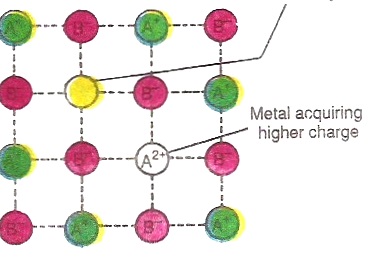
Fig: Metal deficiency defect due to a missing cation.
2) Extra anions occupying interstitial sites:
In this case, the extra anions may be occupying interstitial positions. The extra negative charge is balanced by the extra charges (oxidation of equal number of cations to higher oxidation states) on the adjacent metal ions. Such type of defect is not common because the negative ions are usually very large and they cannot easily fit into the interstitial sites.
Consequence of Metal Deficiency Defects: –
Crystals with metal deficiency defect are semi-conductors. The conductivity is due to the movement of an electron from one ion to another. For example, when an electron moves from ion A+, it changes A+2. Thus the movement of an electron from A+ ion is an apparent movement of A+2 ion. It is called movement of positive hole.
Since the conduction is very low and the current is carried by positive ions, substances permitting this type of conduction are called p-type semiconductors.